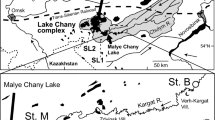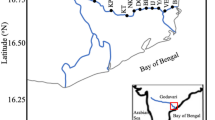Abstract
The temporal variation in the stable carbon and nitrogen isotope ratios of particulate organic matter (POM) in the Rhone River was investigated on a monthly basis during a 2-year period (2004–2005). In spite of high month-to-month variation, interannually consistent seasonal trends appeared, with significantly lower δ13C (<−28.2‰) in spring than in the other seasons. In contrast, δ15N did not exhibit significant temporal variation. In spring and summer, high chlorophyll a and b concentrations were associated with low C/N values (<8) and a high percentage of organic carbon (%C) and organic nitrogen (%N), testifying to high development of autochthonous riverine phytoplankton (mainly diatoms and chlorophytes). In fall and winter, higher δ13C (>−27.2‰) and C/N (>8) values, and lower %C, %N, and chlorophylls concentrations indicated the predominance of allochthonous terrestrial detritus material in the river POM. The lower δ13C values recorded in spring–summer, when the phytoplankton biomass was high, were related to the lower carbon isotopic signatures of freshwater diatoms and chlorophytes compared to those of terrestrial plants. Overall, Rhone River POM was mainly composed of terrestrially derived material (90%), with autochthonous phytoplankton representing only 10% as a mean, in spite of a higher mean contribution of phytoplankton (27%) to river POM in summer.




Similar content being viewed by others
References
Aminot A, Kerouel R (2004) Hydrologie des écosystèmes marins. Paramètres et analyses. Editions Ifremer, 336 pp
Antonelli C, Eyrolle F, Rolland B, Provansal M, Sabatier F (2008) Suspended sediment and 137Cs fluxes during the exceptional December 2003 flood in the Rhone River, southeast France. Geomorphology 95:350–360
Aucour AM, Sheppard SMF, Guyomar O, Wattelet J (1999) Use of δ13C to trace origin and cycling of inorganic carbon in the Rhône river system. Chem Geol 159:87–105
Aucour AM, Sheppard SMF, Savoye R (2003) δ13C of fluvial mollusc shells (Rhône River): a proxy for dissolved inorganic carbon? Limnol Oceanogr 48:2186–2193
Bǎnaru D, Harmelin-Vivien M, Gomoiu MT, Onciu TM (2007) Influence of the Danube River inputs on C and N stable isotope ratios of the Romanian coastal waters and sediment (Black Sea). Mar Pollut Bull 54:1385–1394
Bouwer LM, Vermaat JE, Aerts JCJH (2008) Regional sensitivities of mean and peak river discharge to climate variability in Europe. J Geophys Res 113:D19103. doi:10.1029/2008JD010301
Bravard JP, Clémens A (eds) (2008) Le Rhône en 100 questions. ZABR-GRAIE, Lyon
Caddy JF (2000) Marine catchment basin effects versus impacts of fisheries on semi-enclosed seas. ICES J Mar Sci 57:628–640
Cai DL, Tan FC, Edmond JM (1988) Sources and transport of particulate organic carbon in the Amazon River and estuary. Estuar Coast Shelf Sci 26:1–14
Canuel EA, Cloern JE, Ringelberg DB, Guckert JB, Rau GH (1995) Molecular and isotopic tracers used to examine sources of organic matter and its incorporation into the food webs of San Francisco Bay. Limnol Oecanogr 40:67–81
Cloern JE (2002) Stable carbon and nitrogen isotope composition of aquatic and terrestrial plants of the San Francisco Bay estuarine system. Limnol Oceanogr 47:713–729
Darnaude AM, Salen-Picard C, Polunin NVC, Harmelin-Vivien M (2004) Trophodynamic linkage between river runoff and coastal fishery yield elucidated by stable isotope data in the Gulf of Lions (NW Mediterranean). Oecologia 138:325–332
De Brabandere L, Dehairs F, Van Damme S, Brion N, Meire P, Daro N (2002) δ15N and δ13C dynamics of suspended organic matter in freshwater and brackish waters of the Scheldt estuary. J Sea Res 48:1–15
Descy JP (1993) Ecology of the phytoplankton of the River Moselle: effects of disturbances on community structure and diversity. Hydrobiologia 249:111–116
Dierking J, Wafo E, Schembri T, Lagadec V, Nicolas C, Leyourneur Y, Harmelin-Vivien M (2009) Spatial patterns in PCBs, pesticides, mercury and cadmium in the common sole in the NW Mediterranean Sea, and a novel use of contaminants as biomarkers. Mar Pollut Bull 58:1605–1614
Etcheber H, Tailliez A, Abril G, Garnier J, Servais P, Moatar F, Commarieu MV (2007) Particulate organic carbon in the estuarine turbidity maxima of the Gironde, Loire and Seine estuaries: origin and lability. Hydrobiologia 588:245–259
Ferraton F, Harmelin-Vivien M, Mellon-Duval C, Souplet A (2007) Does spatio-temporal variation in diet affect condition and abundance of European hake (Merluccius merluccius) juveniles in the Gulf of Lions (NW Mediterranean)? Mar Ecol Prog Ser 337:197–208
Finlay JC, Kendall C (2007) Stable isotope tracing of temporal and spatial variability in organic matter sources to freshwater ecosystems. In: Michener R, Lajtha K (eds) Stable isotopes in ecology and environmental science, 2nd edn. Blackwell Publications, USA, pp 283–333
Fruget JF, Centofanti M, Dessaix J, Olivier JM, Druart JC, Martinez PJ (1999) Synthèse des dix premières années de suivi hydrobiologique du Rhône au niveau de la centrale nucléaire de Saint-Alban (France). Hydroécol Appl 1–2(11):29–69
Garnier J, Billen G, Coste M (1995) Seasonal succession of diatoms and Chlorophyceae in the drainage network of the Seine River: observations and modelling. Limnol Oceanogr 40:750–765
Goñi MA, Teixeira MJ, Perkey DW (2003) Sources and distribution of organic matter in a river-dominated estuary (Winyah Bay, SC, USA). Estuar Coast Shelf Sci 57:1023–1048
Gu B, Chapman AD, Schelske CL (2006) Factors controlling seasonal variations in stable isotope composition of particulate organic matter in a soft water eutrophic lake. Limnol Oceanogr 51:2837–2848
Harmelin-Vivien M, Loizeau V, Mellon C, Beker B, Arlhac D, Bodiguel X, Ferraton F, Hermand R, Philippon X, Salen-Picard C (2008) Comparison of C and N stable isotope ratios between surface particulate organic matter and microphytoplankton in the Gulf of Lions (NW Mediterranean). Cont Shelf Res 28:1911–1919
Hein T, Heiler G, Pennetzdorfer D, Riedler P, Schagerl M, Schiemer F (1999) The Danube restoration project: functional aspects and planktonic productivity in the floodplain system. Regul Rivers Res Manag 15:259–270
Hélie JF, Hillaire-Marcel C (2006) Sources of particulate and dissolved organic carbon in the St Lawrence River: isotopic approach. Hydrol Process 20:1945–1959
Hellings L, Dehairs F, Tackx M, Keppens E, Baeyens W (1999) Origin and fate of organic carbon in the freshwater part of the Scheldt Estuary as traced by stable carbon isotope composition. Biogeochemistry 47:167–186
Jacob U, Mintenbeck K, Brey T, Knust R, Beyer K (2005) Stable isotope food web studies: a case for standardized sample treatment. Mar Ecol Prog Ser 287:251–253
Kendall C, Silva SR, Kelly VJ (2001) Carbon and nitrogen isotopic compositions of particulate organic matter in four large river systems across the United States. Hydrol Process 15:1301–1346
Kerhervé P & Sanchez-Vidal A (2007) Stable isotopic tracers (delta13C and delta15N) of riverine inputs into the Gulf of Lions: results from a one-year survey. Rapp Comm Int Mer Médit 38:677
Kerhervé P, Minagawa M, Heussner S, Monaco A (2001) Stable isotopes (13C/12C and 15N/14N) in settling organic matter of the northwestern Maditerranean Sea: biogeochemical implications. Oceanol Acta 24:S77–S85
Lemaire E, Abril G, De Witt R, Etcheber H (2002) Distribution of phytoplankton pigments in nine European estuaries and implications for an estuarine typology. Biogeochemistry 59:5–23
Lionard M, Muylaert K, Tackx M, Vyverman W (2008) Evaluation of the performance of HPLC-CHEMTAX analysis for determining phytoplankton biomass and composition in a turbid estuary (Schelde, Belgium). Estuar Coast Shelf Sci 76:809–817
Lloret J, Lleonart J, Solé I, Fromentin JM (2001) Fluctuations of landings and environmental conditions in the north-western Mediterranean Sea. Fish Oceanogr 10:33–50
Lochet F, Leveau M (1990) Transfers between a eutrophic ecosystem, the river Rhône, and an oligotrophic ecosystem, the north-western Mediterranean Sea. Hydrobiologia 207:95–103
Maksymowska D, Richard P, Piekarek-Jankowska H, Riera P (2000) Chemical and isotopic composition of the organic matter sources in the Gulf of Gdansk (Southern Baltic Sea). Estuar Coast Shelf Res 51:585–598
Mantoura RFC, Llewellyn CA (1983) The rapid determination of algal chlorophyll and carotenoid pigments and their breakdown products in natural waters by reverse phase high-performance liquid chromatography. Anal Chim Acta 151:297–314
Martineau C, Vicent WF, Frenette JJ, Dodson JJ (2004) Primary consumers and particulate organic matter: isotopic evidence of strong selectivity in the estuarine transition zone. Limnol Oceanogr 49:1679–1686
Martinotti W, Camuso M, Guzzi L, Patrolecco L, Pettine M (1997) C, N and their stable isotopes in suspended and sedimented matter from the Po estuary (Italy). Water Air Soil Pollut 99:325–332
Matson EA, Brinson MM (1990) Stable carbon isotopes and the C:N ratio in the estuaries of the Pamlico and Neuse Rivers, North Carolina. Limnol Oceanogr 35:1290–1300
Mook WG, Tan TC (1991) Stable carbon isotopes in rivers and estuaries. In: Degens ET, Kempe S, Richey JE (eds) Biogeochemistry of major world rivers. SCOPE. Wiley, Chichester, pp 245–264
Müller-Solger AB, Jassby AD, Müller-Navarra DC (2002) Nutritional quality of food resources for zooplankton (Daphnia) in a tidal freshwater system (Sacramento-San Joaquim River Delta). Limnol Oceanogr 47:1468–1476
Nohara D, Kitoh A, Hosaka M, Oki T (2006) Impact of climate change on river discharge projected by multimodel ensemble. J Hydrometeorol 7:1076–1089
Ottle C, Etchevers P, Golaz C, Habets F, Noilhan J, Martin E, Ledoux E, Leblois E, Sauquet E, Amaraoui N, Artinian E, Champeaux JL, Guérin C, Lacarrère P, Le Moigne P, Saulnier GM, Thiéry D, Vidal-Madjar D, Voirin S (2001) Hydro-meteorological modelling of the Rhone Basin: general presentation and objectives. Phys Chem Earth B 26:443–453
Pont D, Simmonet JP, Walter AV (2002) Medium-term changes in suspended sediment delivery to the ocean: consequences of catchment heterogeneity and river management (Rhône River, France). Estuar Coast Shelf Sci 54:1–18
Riera P, Richard P (1997) Temporal variation of δ13C in particulate organic matter and oyster Crassostera gigas in Marennes-Oléron Bay (France): effect of freshwater inflow. Mar Ecol Prog Ser 147:105–115
Rolff C, Elmgren R (2000) Use of riverine organic matter in plankton food webs of the Baltic Sea. Mar Ecol Prog Ser 197:81–101
Salen-Picard C, Darnaude AM, Arlhac D, Harmelin-Vivien M (2002) Fluctuations of macrobenthic populations: a link between climate-driven run-off and sole fishery yields in the Gulf of Lions. Oecologia 133:380–388
Sempéré R, Charrière B, Van Wambeke F, Cauwet G (2000) Carbon inputs of the Rhône river to the Mediterranean Sea: biogeochemical implications. Global Biogeochem Cycles 14:669–681
Taylor AH, Geider RJ, Gilbert FJH (1997) Seasonal and latitudinal dependencies of phytoplankton carbon-to-chlorophyll a ratios: results of a modelling study. Mar Ecol Prog Ser 152:51–66
Tesi T, Miserocchi S, Goñi MA, Langone L (2007) Source, transport and fate of terrestrial organic carbon on the western Mediterranean Sea, Gulf of Lions. France Mar Chem 105:101–117
Vuorio K, Meili M, Sarvala J (2006) Taxon-specific variation in the stable isotopic signatures (δ13C and δ15N) of lake phytoplankton. Freshw Biol 51:807–822
Wissel B, Fry B (2005) Tracing Mississipi River influences in estuarine food webs of coastal Louisiana. Oecologia 144:659–672
Acknowledgements
This research was supported by the French National programmes PNEC-MEDOC and ECCO-PNBC. The second author was supported by a research stipend of the Okeanos foundation (Germany). We are grateful to Chantal Salen-Picard for assistance in sampling and to Charlie Scrimgeour (Mylnefield Lipid Analysis-SCRI) for stable isotope analyses. Thanks are expressed to the editor and two reviewers for their most valuable comments and improvement on the manuscript.
Author information
Authors and Affiliations
Corresponding author
Rights and permissions
About this article
Cite this article
Harmelin-Vivien, M., Dierking, J., Bănaru, D. et al. Seasonal variation in stable C and N isotope ratios of the Rhone River inputs to the Mediterranean Sea (2004–2005). Biogeochemistry 100, 139–150 (2010). https://doi.org/10.1007/s10533-010-9411-z
Received:
Accepted:
Published:
Issue Date:
DOI: https://doi.org/10.1007/s10533-010-9411-z




